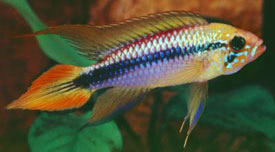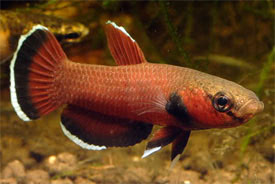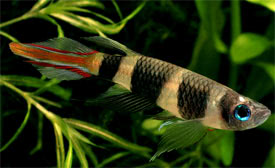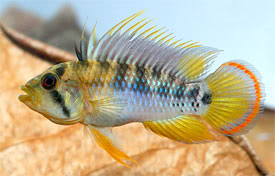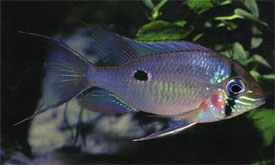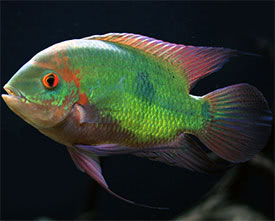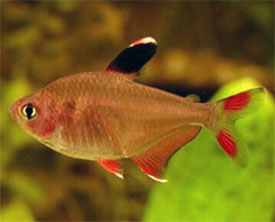
 Magyarul / Hungarian
Magyarul / Hungarian
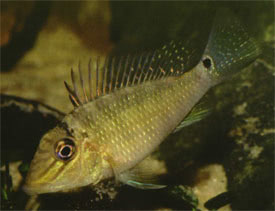
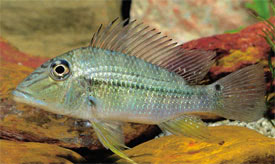
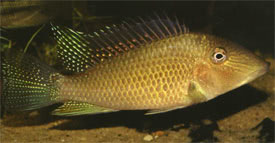
- Scientific name: Satanoperca jurupari
- Synonyms: Geophagus jurupari
- Common name: Jurupari Eartheater, Demon eartheater
- Group: Cichlids
- Habitat: South America; Venezuela, Colombia, Guyana, Suriname, French Guiana, Ecuador, Peru, Bolivia and Brazil.
- Size: 18-25 cm
- Biotope: Inhabits in slower-moving sections of rivers with sandy or muddy bottoms, but also found around estuaries, coastal swamps and lagoons.
- Social behavior: Generally a peaceful cichlid, but may fight with conspecifics. They should be kept in a small group of 5 or more fish. They may prey on small fish.
- Diet: Omnivorous; In nature they eat almost everything, from small invertebrates to fruits In aquarium they aren’t fussy eaters, any live and frozen foods have taken, however they require a great amount of vegetable matter, like spirulina alage or cucumber.
- Breeding: Hard
- Tank: Minimum 250 litres
- Population: 5-6 fish for 600 litres
- Decoration: They require a very fine/soft substrate in which to search for edible matter. A few hiding places in the form of roots/wood, or dense vegetation, and a layer of various floating plants to provide shade, will be beneficial to the well-being of the fish.
- Temperature: 25-30 °C
- pH: 4.3-7.2
- Hardness: 1-10 NK°
- Lifespan: 5-8 years
Description: The name jurupari is taken directly from the language of the indigenous local people and means, roughly "devil". Satanoperca jurupari in one of the most widespread cichlids in South America. Its distribution encompasses the entire Amazon basin and its northern and southern affluents. The yellowish to emerald green coloration creates immediate eye appeal. Fins are mostly translucent with traces of iridescence. Their coloration depending on mood, every population may exhibit a more or less visible pattern of bars on the flanks. It may be possible to detect a horizontal lateral band that begins at the posterior operculum and ends on the caudal peduncle, as a number of vertical stripes on the flanks. There is a more or less large ocellus on the caudal peduncle. Perhaps the most striking character is the head pattern. It is often possible to discern two dark brown or reddish parallel stripes running upwards from the corner of the mouth to the eye. In addition there may be two further parallel dark bars ont he forehead, which appear to join the eyes together. The Satanoperca jurupari is often confused in the hobby with the Satanoperca leucosticta. The easiest and fastest way to differentiate species is the absence of white spots on the operculum of the Satanoperca jurupari. While the Satanoperca jurupari is often found in black water conditions in its natural habitat, it easily acclimates to the higher ph ranges. Like the other mid to large bodied cichlids the Satanoperca jurupari is susceptible to Hole-In-The-Head disease so attention to water quality and a steady diet is essential. During feeding they often dig and uproot plants.
It is not easy to visually sex this fish. Mature males are usually slimmer than females. For breeding use soft and a slightly acidic water with a higher temperature of 28°C. Jurupari Eartheater is a maternal ovophilous mouthbrooder which maintains a loose pair bond during brood care. The female will pick up the eggs immediately after fertilization and carry them until hatched. Pair formation is extremely peaceful and in some cases barely noticeable. Instead you suddenly notice that the fishes are cleaning their chosen substrate, and spawning begins soon afterwards. The spawning substrate may be a stone or a piece of wood, provided it offers a horicontal surface. During the cleaning of the spawning site the partners circle each other a few times and during this phase synchronise their movements for the actual spawning. The eggs are laid in straight lines on the substrate, then fertilised by the male, and then immediately taken into the mouth cavity of the female. The actual brood care is exclusively the task of the female, and the female always seeks out the quietest part of the aquarium and stays out of the way of other fishes. At 28 °C the larvae are released from their mother’s mouth for the first time after about 10 days. At this stage the yolk sac is still clearly evident and the larvae do not take food. After another 2 days the yolk has been absorbed to the point where feeding with Artemia nauplii can begin. For a couple days thereafter the fry are taken into the mother’s mouth in the event of danger and at night, although by then there will no longer be room for all of them.




















